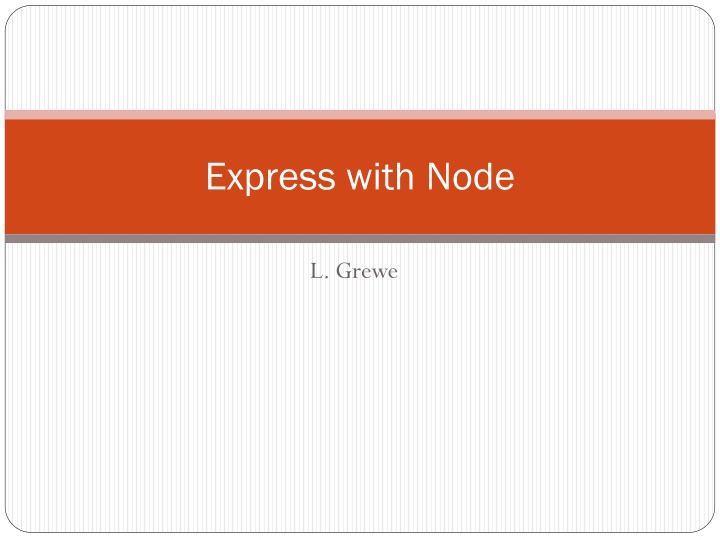The Benefits of Using Express with Node.js
Learn how Express enhances Node.js by providing a structured project layout, simplified routing, and easier development workflow, making it a versatile choice for web and mobile applications. Discover how to set up a new Node.js and Express project and organize your code efficiently.
Download Presentation

Please find below an Image/Link to download the presentation.
The content on the website is provided AS IS for your information and personal use only. It may not be sold, licensed, or shared on other websites without obtaining consent from the author.If you encounter any issues during the download, it is possible that the publisher has removed the file from their server.
You are allowed to download the files provided on this website for personal or commercial use, subject to the condition that they are used lawfully. All files are the property of their respective owners.
The content on the website is provided AS IS for your information and personal use only. It may not be sold, licensed, or shared on other websites without obtaining consent from the author.
E N D
Presentation Transcript
Express with Node L. Grewe
What does Express add to NodeJS minimal and flexible Node.js web application framework that provides a robust set of features for web and mobile applications. Provides EASIER WAY (than just nodeJS). What does the this mean? Note: sometimes Express is thought of as minimalistic (there are other frameworks like Meteor that are more complex)
Feature 1 Project structure
FEATURE 1: It adds the project structure we saw before for NodeJS + Express This kind of multi-folder architecture is sometimes called a scaffolded app Note: even if you do not use an IDE but, Create a NodeJS project using command line npm tool you get a similar directory structure This partitioning (towards MVC pattern) is a good one and helps with breaking up of code Components which allows for more reuse, easier code, better growth/extensions and is easier when working with a group.
Getting Express + NodeJS project OPTION 1: create new NodeJS + Express project in WebStorm o WATCH VIDEO OPTION 2: (do 1 instead use Webstorm) if not using WebStorm IDE can create new NodeJS + Express project on command line by going to desired directory and typing npm install express-generator -g express nameOfApp NOTE: you can t easily add Express to an existing NodeJS directory ---as it completely changes the filestructre
Feature 2 ROUTING
FEATURE 2: Express also basic routing Routing is mapping URIs + Request Type -> code/static page Here are some method calls on the express instance that are related to HTTP request type how application responds to client request to a particular endpoint, which is a URI (or path) and a specific HTTP request method (GET, POST, and so on). Example: request for /getAllRoutes might map to the controller code located in controller/getAllRoutes.js
Where is the code for routing located In a javascript file in the routes directory In the following project there are 2 files index.js and users.js that contain routing code
Routing Code-- what is this app object In your code after requiring the express module, you declare an instance of express object called app simple index.js file Remember this inside a routing file in routes directory //require the Express module and call express var express = require('express') var app = express() //Following declares URI path / will cause the message Hello World to be sent app.get('/', function (req, res) { res.send('Hello World!') }) //application will listen for requests on port number 300 app.listen(3000, function () { console.log('Example app listening on port 3000!') })
Examining the simple routing code simple index.js file Remember this inside a routing file in routes directory //require the Express module and call express var express = require('express') var app = express() Require express module declare app = express instance //Following declares URI path / will cause the message Hello World to be sent app.get('/', function (req, res) { res.send('Hello World!') }) When request for / comes in with request type = get then send response text Hello World! //application will listen for requests on port number 300 app.listen(3000, function () { console.log('Example app listening on port 3000!') })
RUNNING: The basic flow of a Node+Express app 1) START APPLICATION: launch app and listens for requests at the specified port in www.js AND sets up routing maps as specified in the required app.js file (which in turn can call in different routing files in routes directory) 2) USER REQUEST COMES IN: using routing information invokes the appropriate controller logic found in routes and this can involve calling other js programs that communicate with Database/Data servers or 3rd party (like ups etc). Then the data (if any) is bound to a template (a view found in views directory) and rendered and the response is delivered to the user.
Here is example of a www.js file #!/usr/bin/env node /** * Module dependencies. */ var app = require('../app'); //THIS will load the app.js file that sets up routing var debug = require('debug')('nodejsexpresswebstorm:server'); var http = require('http'); /** * Get port from environment and store in Express. */ var port = normalizePort(process.env.PORT || '3000'); app.set('port', port); /** * Create HTTP server. */ var server = http.createServer(app);
www.js file continued /** * Listen on provided port, on all network interfaces. */ server.listen(port); server.on('error', onError); server.on('listening', onListening); /** * Normalize a port into a number, string, or false. */ function normalizePort(val) { var port = parseInt(val, 10); if (isNaN(port)) { // named pipe return val; } if (port >= 0) { // port number return port; } return false; }
www.js file continued /** * Event listener for HTTP server "error" event. */ function onError(error) { if (error.syscall !== 'listen') { throw error; } var bind = typeof port === 'string' ? 'Pipe ' + port : 'Port ' + port; // handle specific listen errors with friendly messages switch (error.code) { case 'EACCES': console.error(bind + ' requires elevated privileges'); process.exit(1); break; case 'EADDRINUSE': console.error(bind + ' is already in use'); process.exit(1); break; default: throw error; } } /** * Event listener for HTTP server "listening" event. */ function onListening() { var addr = server.address(); var bind = typeof addr === 'string' ? 'pipe ' + addr : 'port ' + addr.port; debug('Listening on ' + bind); }
Here is example of app.js file Notice it loads (requires) a number of routes files And later it Specifies some middleware functions it will execute
Another routing code example NOTE: for each request type (GET, POST, PUT, DELETE, etc) there is a method call on our express object app generic example for POST request: app.post( URI , function(req, res) { res.send('Hello World!') }); Remember this inside a routing file in routes directory
Another Routing example var cool = require('cool-ascii-faces'); var express = require('express'); var app = express(); var pg = require('pg'); Remember this inside a routing file in routes directory //map URI /nodeMongoDBTest to nodeMongoDBTest.ejs in the sub-directory pages app.get('/', function(request, response) { response.render('pages/index'); }); //map URI /nodeMongoDBText to the page pages/nodeMongoDBTest app.get('/nodeMongoDBTest', function(request, response) { response.render('pages/nodeMongoDBTest'); }); //when URI /cool requested call the cool function from the cool module required at top app.get('/cool', function(request, response) { response.send(cool()); }); //when URI /times requested call the inline function which increments #times run app.get('/times', function(request, response) { var result = '' var times = process.env.TIMES || 5 for (i=0; i < times; i++) result += i + ' '; response.send(result); });
Decomposing the app.get call Remember this inside a routing file in routes directory
What is the request and response obejcts in our app.get( uri , function(request,response, next) method The req object represents the HTTP request and has properties for the request query string, parameters, body, HTTP headers, and so on. Request Object req.params.name_of_param For example: app.get('/user/:id', function(req, res) { res.send('user ' + req.params.id); }); But you could just as well have: app.get('/user/:id', function(request, response) { response.send('user ' + request.params.id); }); req.baseUrl, req.body, req.cookies (req.cookies.name_of_cookie), req.hostname, req.path, etc see documentation Remember this inside a routing file in routes directory
More on the request object Remember this inside a routing file in routes directory Body of Request = if you want to see the body of the request for printing it out do the following console.log(JSON.stringify(req.body)); req.body Contains key-value pairs of data submitted in the request body. EXAMPLE (handler code): var body = JSON.stringify(req.body); var params = JSON.stringify(req.params); res.send("recieved your request!</br>" + "parameters: " + params + "</br>URL:" + req.url + "body: " + body); will produce HTML Form say: Response hi to: Express forms
Example passing parameters in URL Suppose you want to send parameters in URL such as http://localhost:3000/users/34/books/8989 Where 34 is the id of the user and the book is 8989 app.get('/users/:userId/books/:bookId', function (req, res) { res.send(req.params) } ); Remember this inside a routing file in routes directory Result is
The response object Has a series of the expected useful methods in building a response like: res.render, res.send, res.cookie, res.redirect, and many more
What if you want all request types to respond the same way use the 3 parameter version of handler function that has next as 3rd parameter app.all('/secret', function (req, res, next) { console.log('Accessing the secret section ...'); next(); // pass control to the next handler }); Remember this inside a routing file in routes directory
Where is this next handler --- we are not done you must define them in app.*() method var cb0 = function (req, res, next) { console.log('CB0'); next(); } var cb1 = function (req, res, next) { console.log('CB1'); next(); } var cb2 = function (req, res) { res.send('Hello from C!'); } // DEFINE MULTIPLE handler functions for the URI /example/c app.get('/example/c', [cb0, cb1, cb2]); Remember this inside a routing file in routes directory
Routing Patterns acd and abcd. app.get('/ab?cd', function (req, res) { res.send('ab?cd') }) abcd,abbcd,abbbcd, and so on. app.get('/ab+cd', function (req, res) { res.send('ab+cd') }) abcd,abxcd,abRANDOMcd,ab123cd, and so on. app.get('/ab*cd', function (req, res) { res.send('ab*cd') }) /abe and /abcde. app.get('/ab(cd)?e', function (req, res) { res.send('ab(cd)?e') }) Remember this inside a routing file in routes directory
more Routing Patterns match anything with an a in the route name. app.get(/a/, function (req, res) { res.send('/a/') }) Remember this inside a routing file in routes directory
app.route() You can create chainable route handlers for a route path Remember this inside a routing file in routes directory
express.Router remember our app object was instance of express() Remember this inside a routing file in routes directory
Feature 3 TEMPLATE ENGINE
FEATURE 3: Supports Template Engines templates let you embed backend variables into a file and when requested it renders the file with the variables set to their actual values uses EJS or Jade/Pug (template engine) and others are supported. WE WILL HAVE A FUTURE lecture on this
FEATURE 4: Express is partially MVC We can make it more ---and this is the practice of our class
Feature 4: partially MVC first, if you dont know what MVC is review on CS3340 page or visit the lecture from 6320. ......reminder, MVC is a currently a very desirable pattern to implement in your web framework and we are going to do it Not strongly MVC VIEW = in the views directory using some supported template engine like EJS or Jade/Pug. CONTROLLER = embedded in the code found in the routes directory MODEL = there is no default setup for Models in Express+NodeJS
How to make it more MVC Make controllers directory In a routers file like index.js (in Routes directory) ands code that maps URI to a controller code method //*****new index.js file var controllerMain = require('../controllers/main ); //this will load the controller file below /* GET home page. */ router.get('/', controllerMain.index); //calls the controller code the function index
Make the new controller file main.js in controllers directory /*/* GET home page. */ module.exports.index = function(req, res, next) { res.render('index', { title: 'CS at CSUEB' }); }; NOTE: defining the function with the tag module.exports.index exports the function under the name index. ALSO note that the call in the router will AUTOMATICALLY pass the request and response object NOTE: pass data from controller --> view via JSON format { title: 'CS at CSUEB'} ...generically this is { variableName: 'value' } to pass more separate by commas, for example { title: 'CS at CSUEB' , course: 'Web Development', professor: 'L. Grewe' }
Now the view file in the views directory Here is example of index.ejs that takes in data of "title" <!DOCTYPE html> <html> <head> <title><%= title %></title> <link rel='stylesheet' href='/stylesheets/style.css' /> </head> <body> <h1><%= title %></h1> <p>Welcome to <%= title %> right now & here</p> </body> </html> The view accesses data sent from Controller through the variable name. Example <%= title >
Different example of view reading in data getAllRoutes.ejs view that expects rows of entries (an array) from the Routes database "table" and this data is given to this code in the variable "results"and this code cycles through the rows and displays some of the content (latitude and longitude) <!DOCTYPE html> <html> <head> <title>mLab MongoDB test</title> <link rel='stylesheet' href='/stylesheets/style.css' /> </head> <body> <div class="container"> <h2>Database Results getting Routes </h2> <ul> <% results.forEach(function(r) { %> <li><%= r.name %> - <%= r.frequency %> From:(<%=r.START_Longitude %>, <%=r.START_Latitude %> ) TO:(:(<%=r.END_Longitude %>,<%=r.END_Latitude %>) </li> <% }); %> </ul> </div> </body></html>
More on sending data from controller to view Nesting Data ***** in main.js file in controllers directory /* GET home page. */ module.exports.index = function(req, res, next) { res.render('index', { title: 'CS at CSUEB , courseInfo: { name: 'Web Design , professor: 'L. Grewe } }); }; Here is example of index.ejs that takes in data of "title" and nested "courseInfo" <!DOCTYPE html> <html> <head> <title><%= title %></title> <link rel='stylesheet' href='/stylesheets/style.css' /> </head> <body> <h1><%= title %></h1> <p>Welcome to the course <%= courseInfo.name %> which is beging taught by <%= courseInfo.professor %> </p>
sending array data controller to view /***** in main.js file in controllers directory /* GET home page. */ module.exports.index = function(req, res, next) { res.render('index , { title: 'CS at CSUEB , courseInfo: { name: 'Web Design', professor: 'L. Grewe }, otherCourses : [ { name: 'CS 1', professor: 'L. Ertaul }, { name: 'Newtworking', professor: 'L. Christiansan }, { name: 'Computer Vision', professor: 'L. Grewe' } ] }); }; Here is example of index.ejs that takes in data of "title" and nested "courseInfo" and the array otherCoursesand displays them <!DOCTYPE html> <html> <head> <title><%= title %></title> <link rel='stylesheet' href='/stylesheets/style.css' /> </head> <body> <h1><%= title %></h1> <p>Welcome to the course <%= courseInfo.name %> which is beging taught by <%= courseInfo.professor %> </p> <h3> Other Courses: </h3> <ul> <% otherCourses.forEach(function(r) { %> <li> Course: <%= r.name %> , Professor: <%=r.professor %> </li> <% }); %> </ul> </body> </html> .....typically this data will come from a database query or some kind of dynamic data retrieval but, to show that you can hard code an array in the controller here is an example
Model When we talk about databaseswill revisit this
Feature 5 MIDDLEWARE
FEATURE 5: Middleware A number of functions executed PRIOR to the handler
Middleware function which takes as parameters: req, res and next function
Middleware examples Has code to process requests & perform other middleware operations: Cookies Body parsing Logging Authentication Your code must declare their use var app = express(); app.use(cookieParser()); app.use(bodyParser()); app.use(logger()); app.use(authentication()); app.get('/',function (req, res) { // ...}); app.listen(3000);
What is app.use() ???? app.use() = specify middleware to execute (can call multiple times) EXAMPLE 1: middleware that is called ALWAYS regardless of URI request var express = require('express'); var app = express(); Remember this inside a routing file in routes directory //Simple request time logger app.use(function(req, res, next){ console.log("A new request received at " + Date.now()); //This function call is very important. It tells that more processing is //required for the current request and is in the next middleware function/route handler. next(); });
app.use() example 2 var express = require('express'); var app = express(); if have a get request for / will first execute myLogger then go to app.get handler function that sends Hello World1 var myLogger = function (req, res, next) { console.log('LOGGED'); next(); } app.use(myLogger); app.get('/', function (req, res) { res.send('Hello World!') }); app.listen(3000)
app.use() example 3 var express = require('express'); var app = express(); where you call middleware only if URI is /things then will go next to app.get handler code which sends Things string //Middleware function to log request protocol app.use('/things', function(req, res, next){ console.log("A request for things received at " + Date.now()); next(); }); //Route handler that sends the response app.get('/things', function(req, res){ res.send('Things'); }); app.listen(3000);
Order in app.use() is important In order of appearance of code in route file
A specific middlware example FORM PROCESSING
Middleware Form Processing NEW package.json { "name": "nodejsexpresswebstorm "version": "0.0.0", "private": true, "scripts": { "start": "node ./bin/www" }, "dependencies": { "body-parser": "^1.17.2", "cookie-parser": "~1.4.3", "debug": "~2.6.3", "ejs": "~2.5.6", "express": "~4.15.2", "mongodb": "^2.2.31", "morgan": "~1.8.1", "multer": "^1.3.0", "serve-favicon": "~2.4.2" } } STEP 1: install body-parsers and multer packages *** assumming you have already created a basic express applicaiton project ***** install the body-parser(for parsing JSON and url-encoded data) and multer(for parsing multipart/form data) middleware. GO to your terminal window in application and type npm install --save body-parser multer
Form Processing Body parser This is used to parse the body of requests which have payloads attached to them. To mount body parser, we need to install it using npm install --save body-parser and to mount it, include the following lines in your index.js: To view all available options for body-parser, visit its github page. var bodyParser = require('body-parser'); //To parse URL encoded data app.use(bodyParser.urlencoded({ extended: false })); //To parse json data app.use(bodyParser.json());























